General, Sir John Monash, Personal Files Book 20, 15 August - 8 September 1918 - Part 13
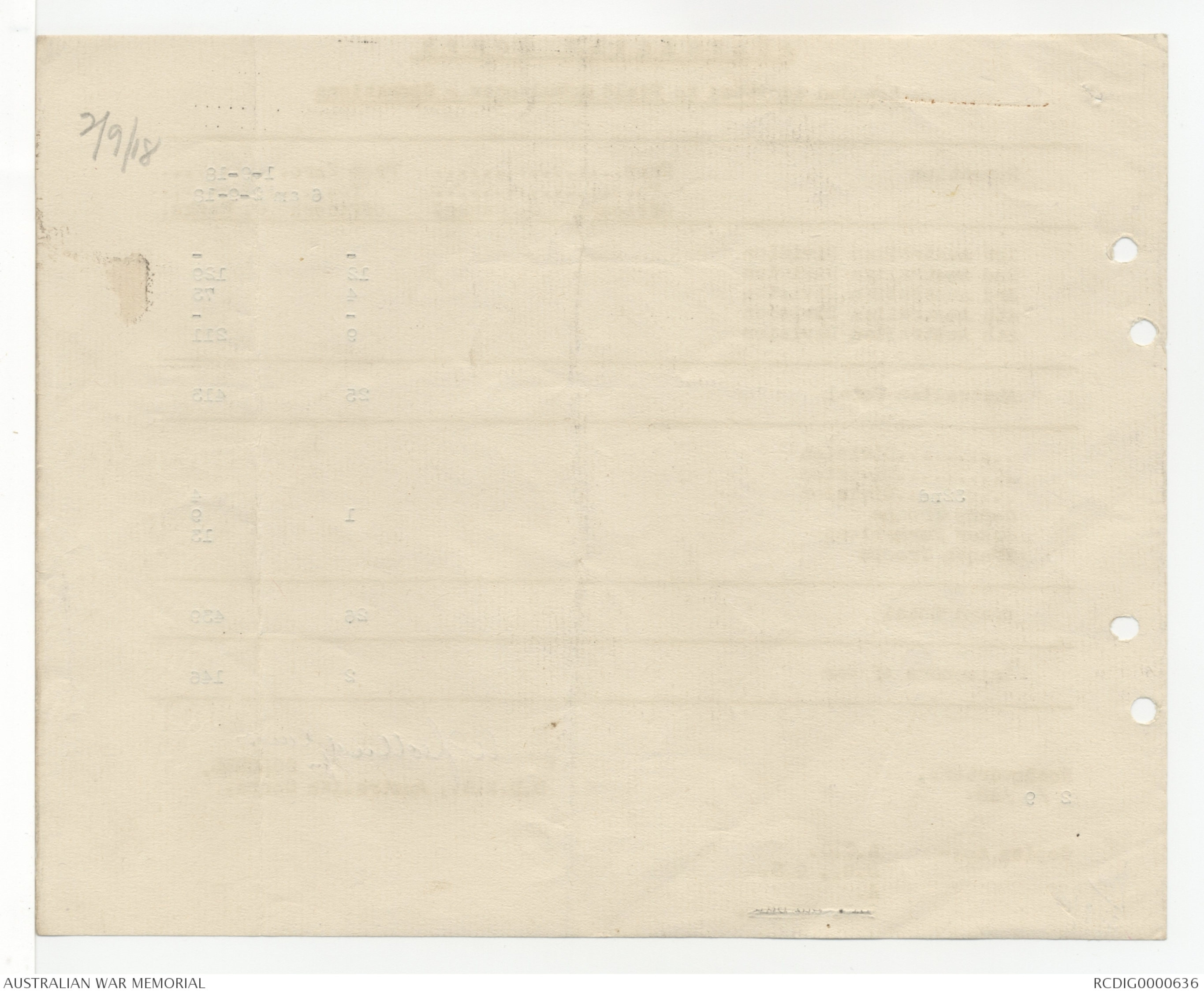
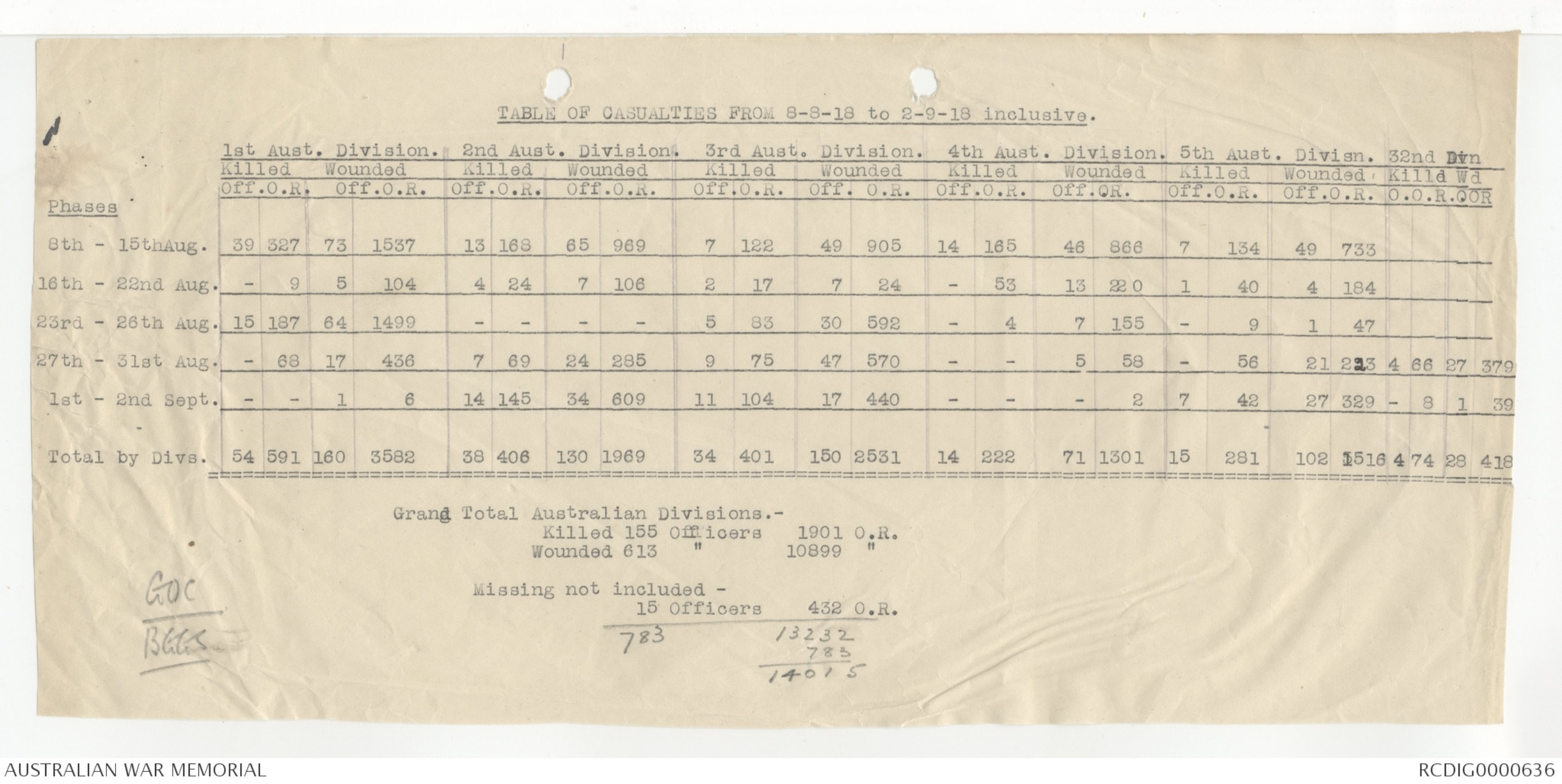
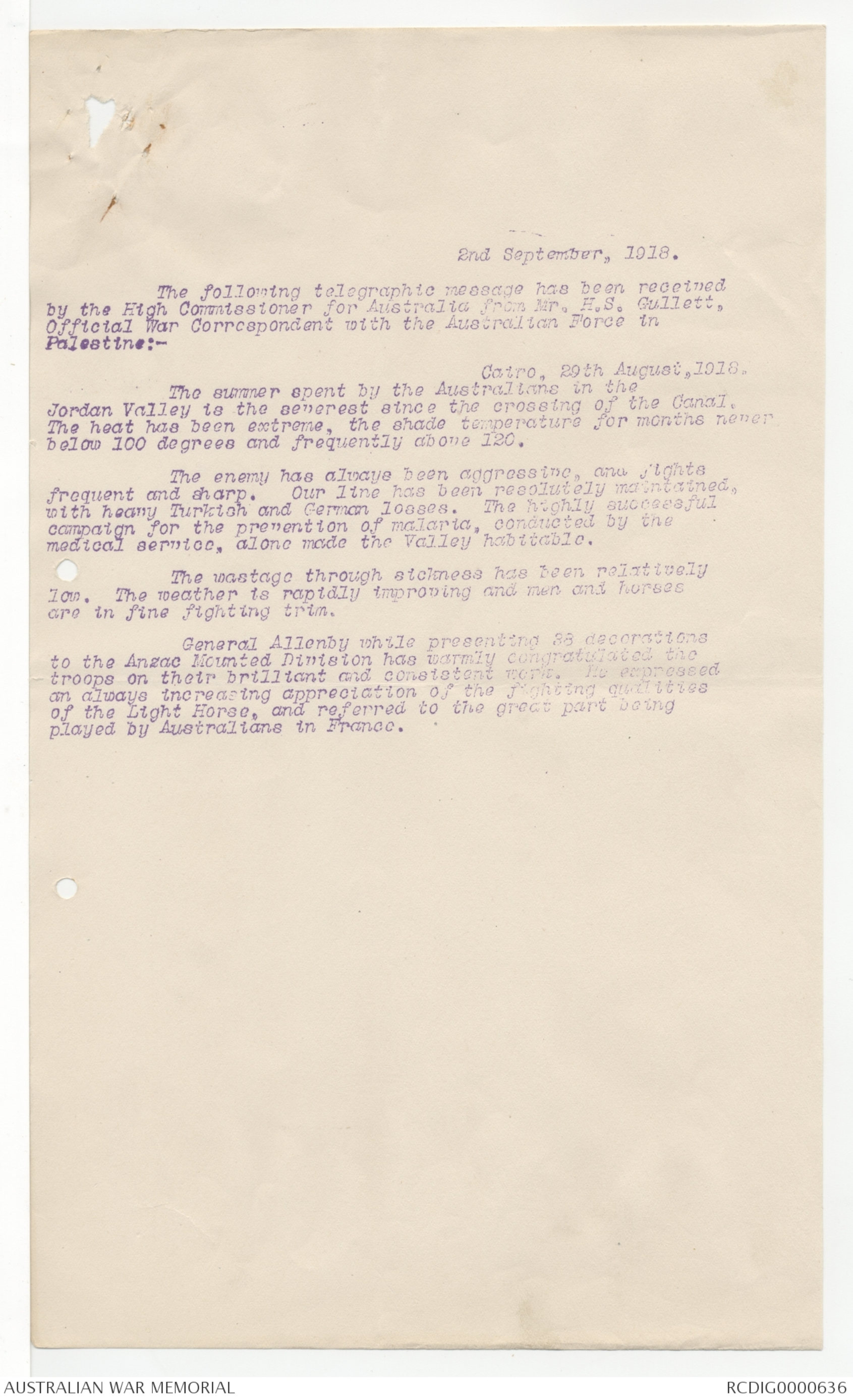
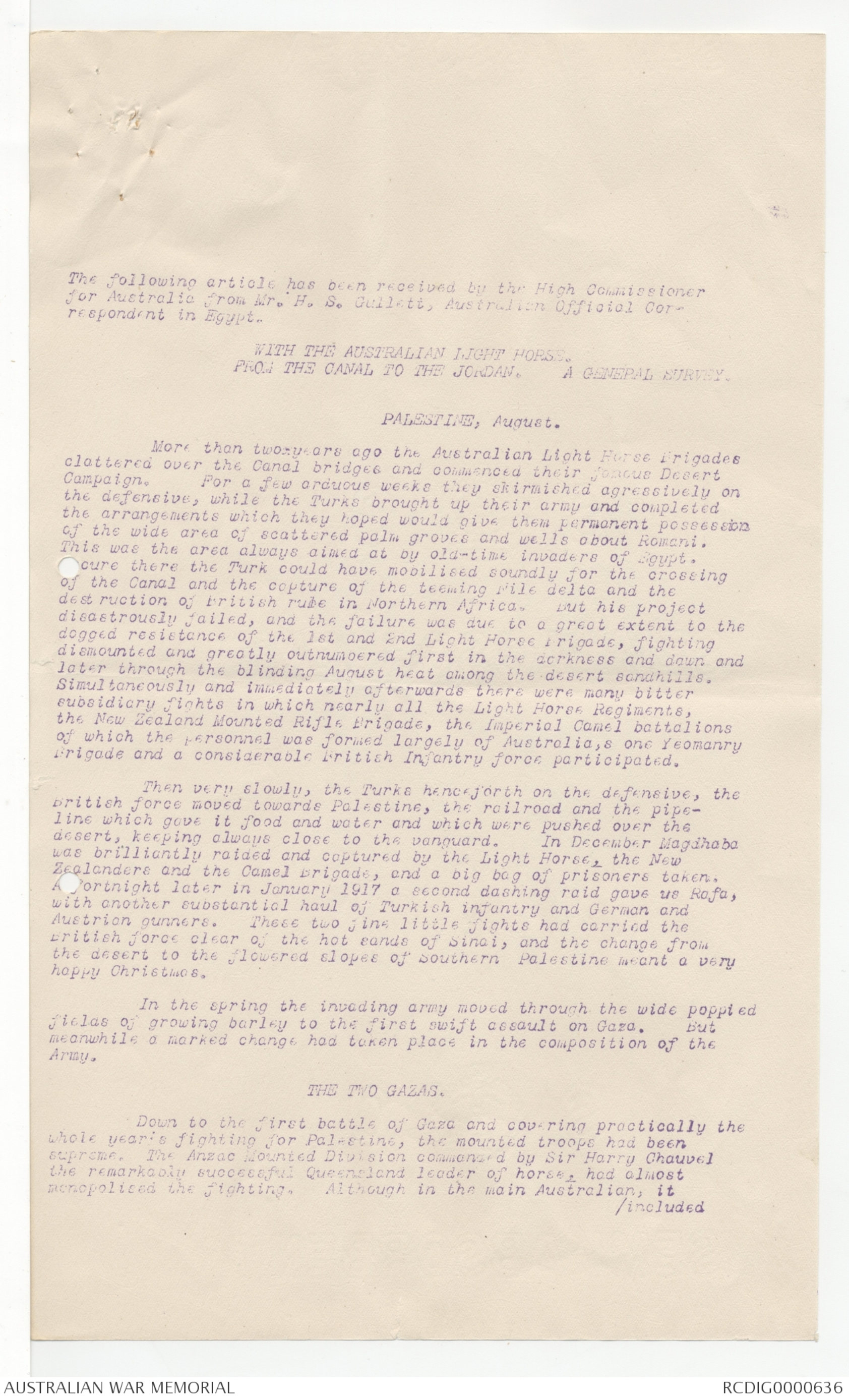
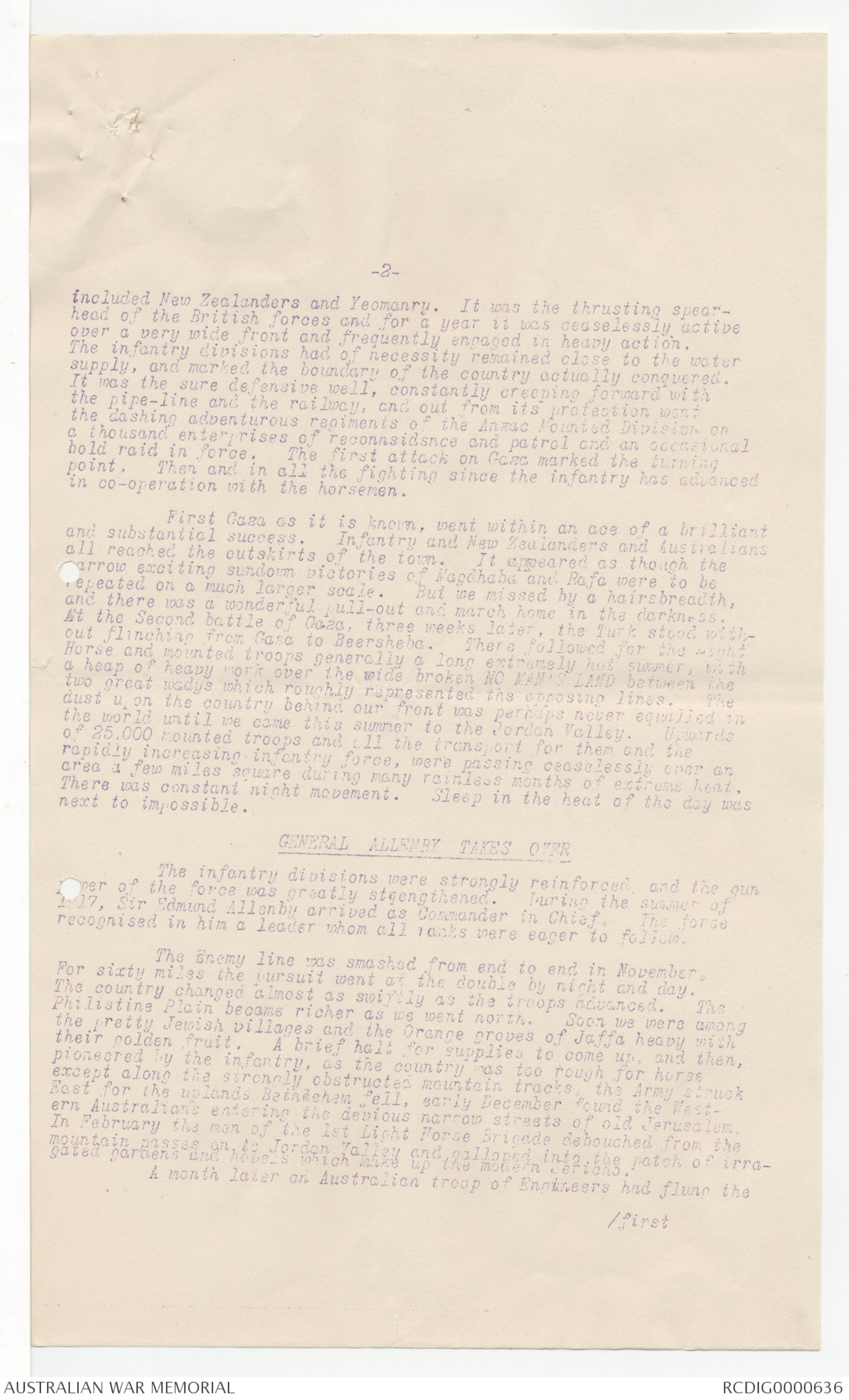
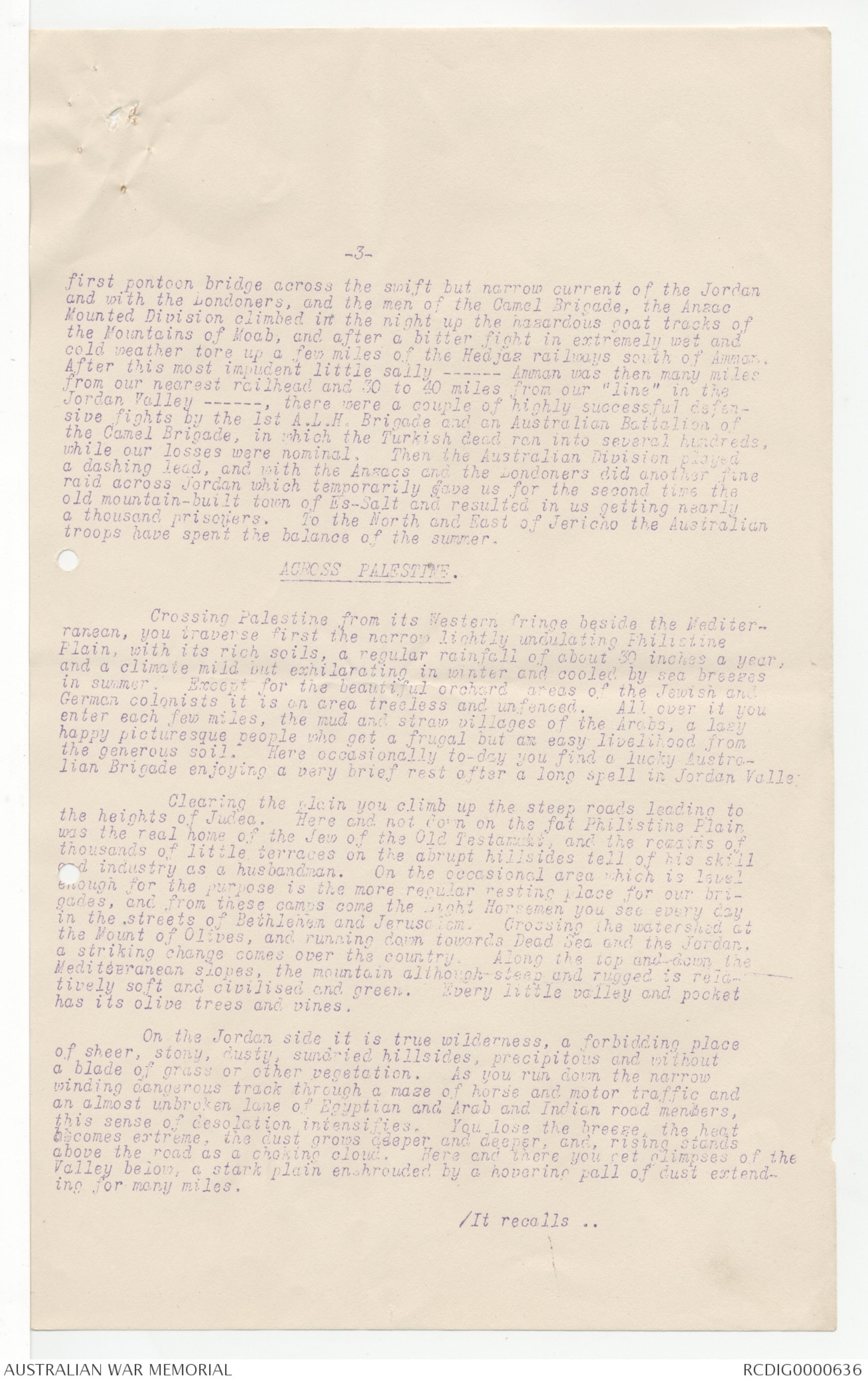
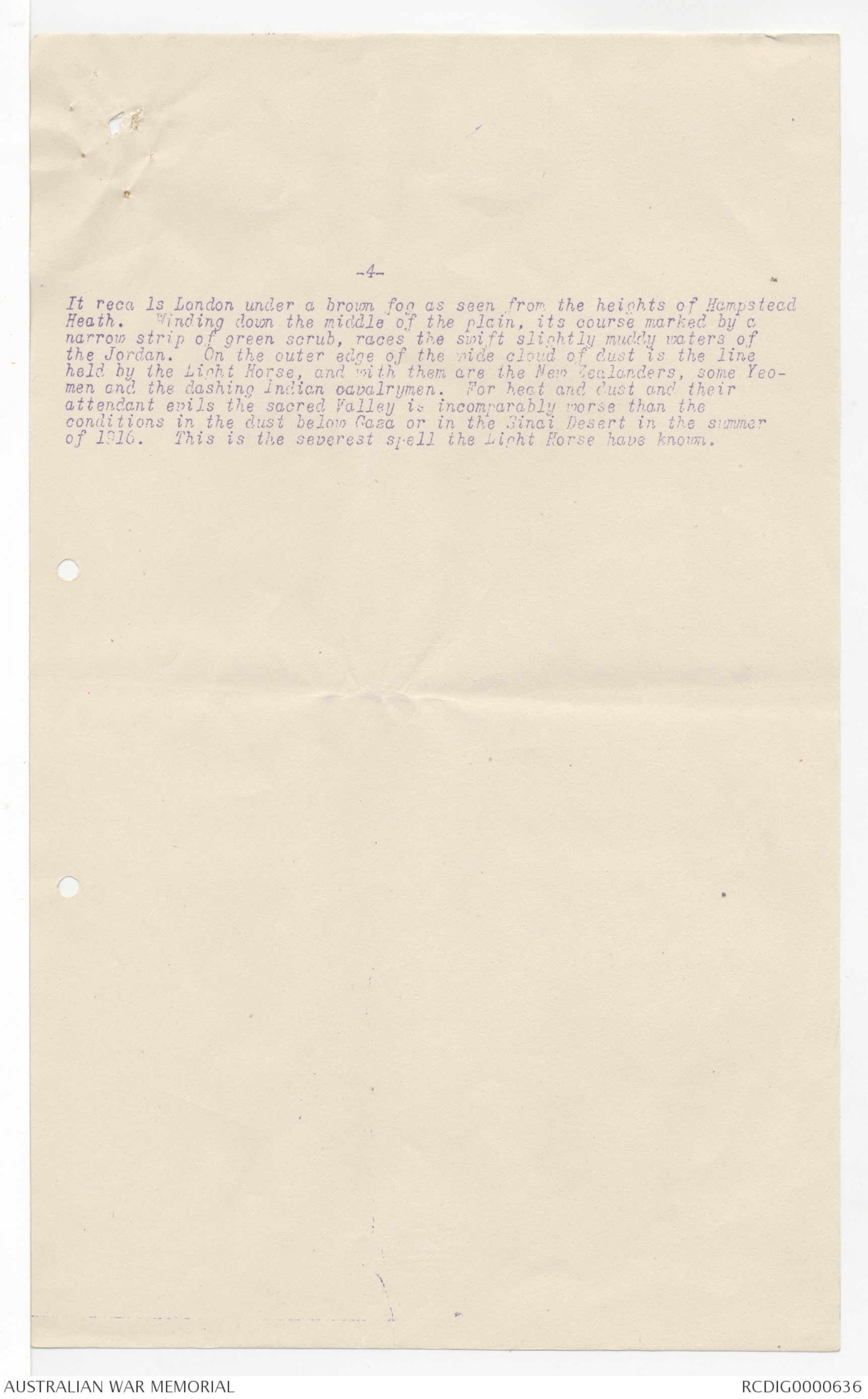
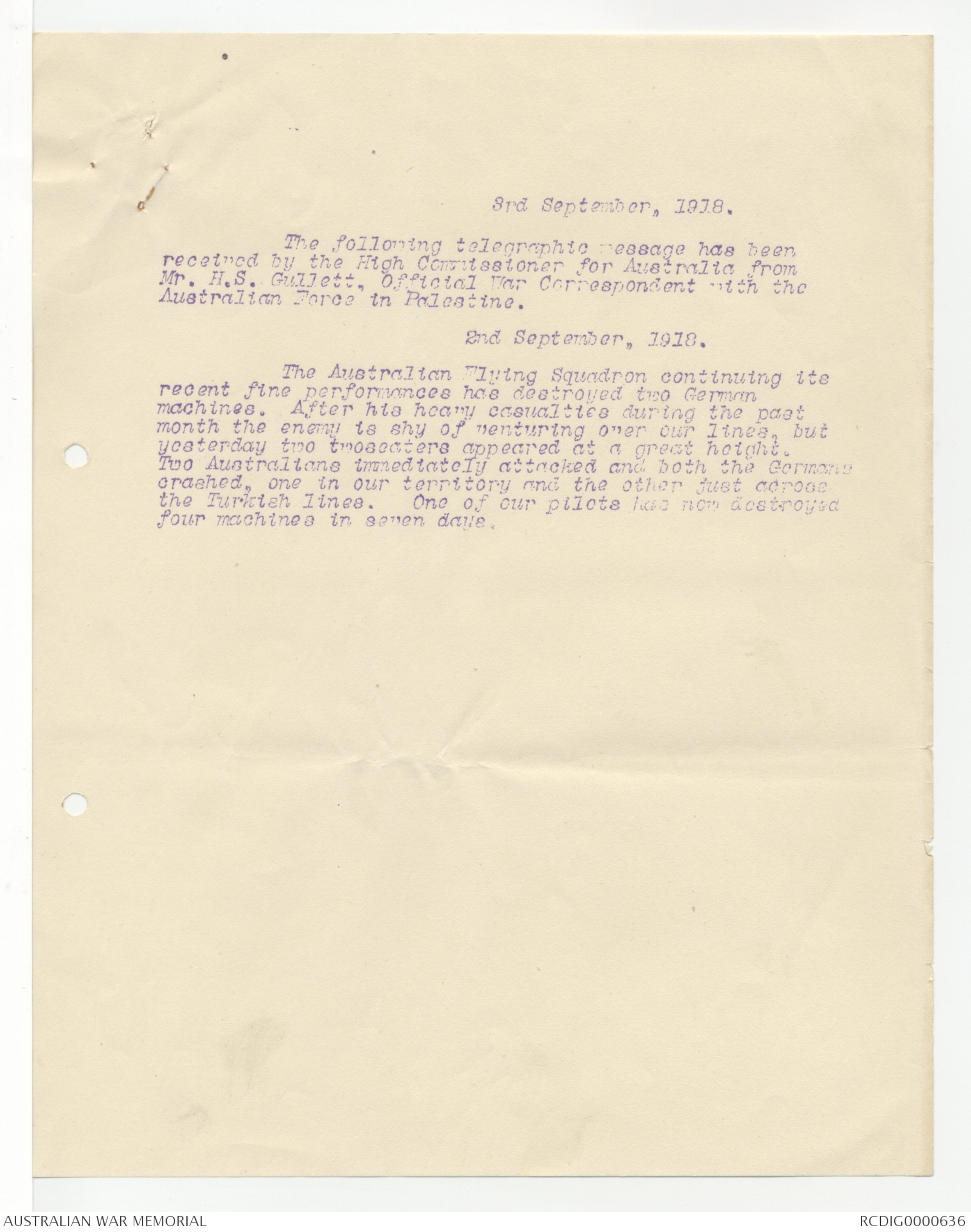
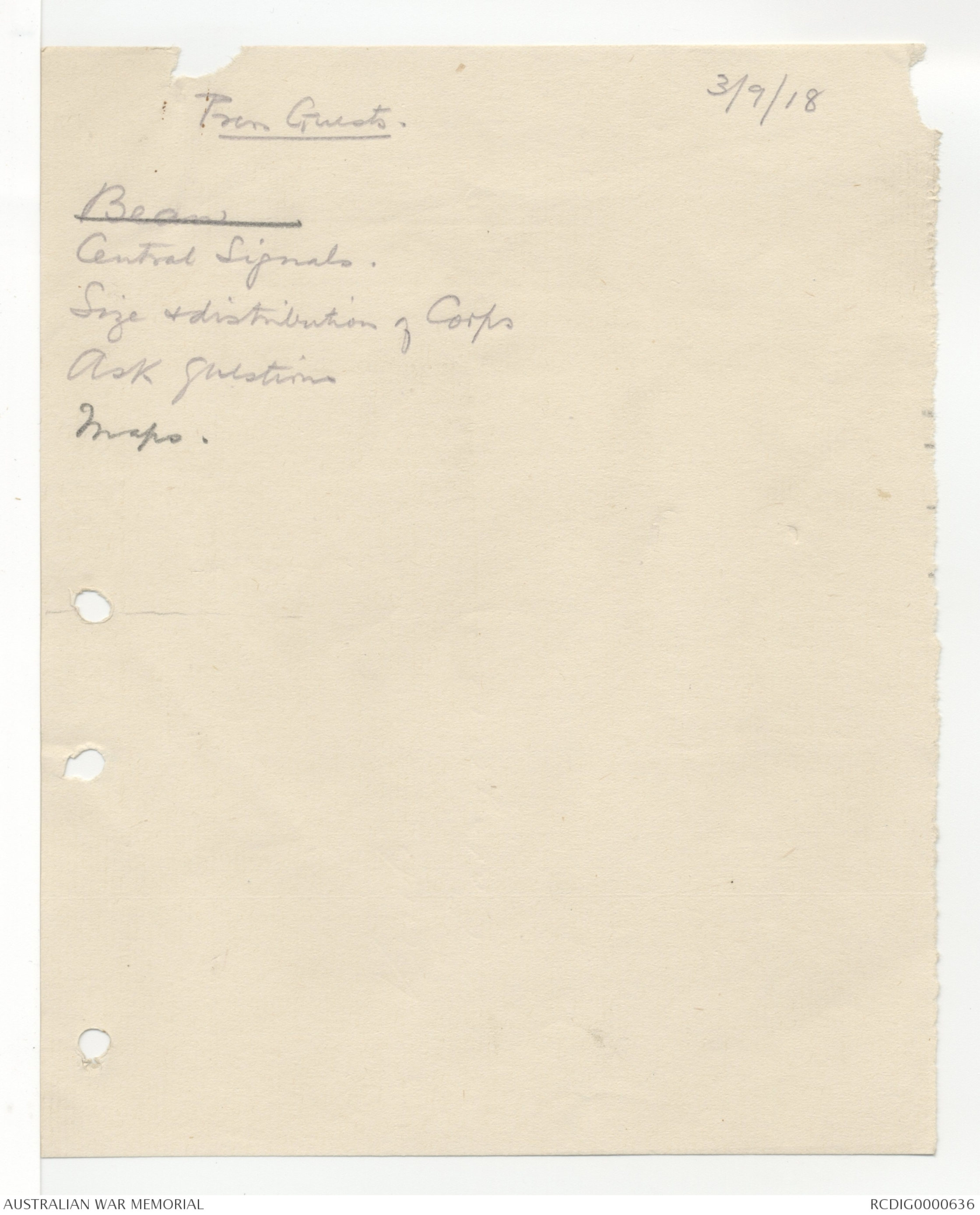
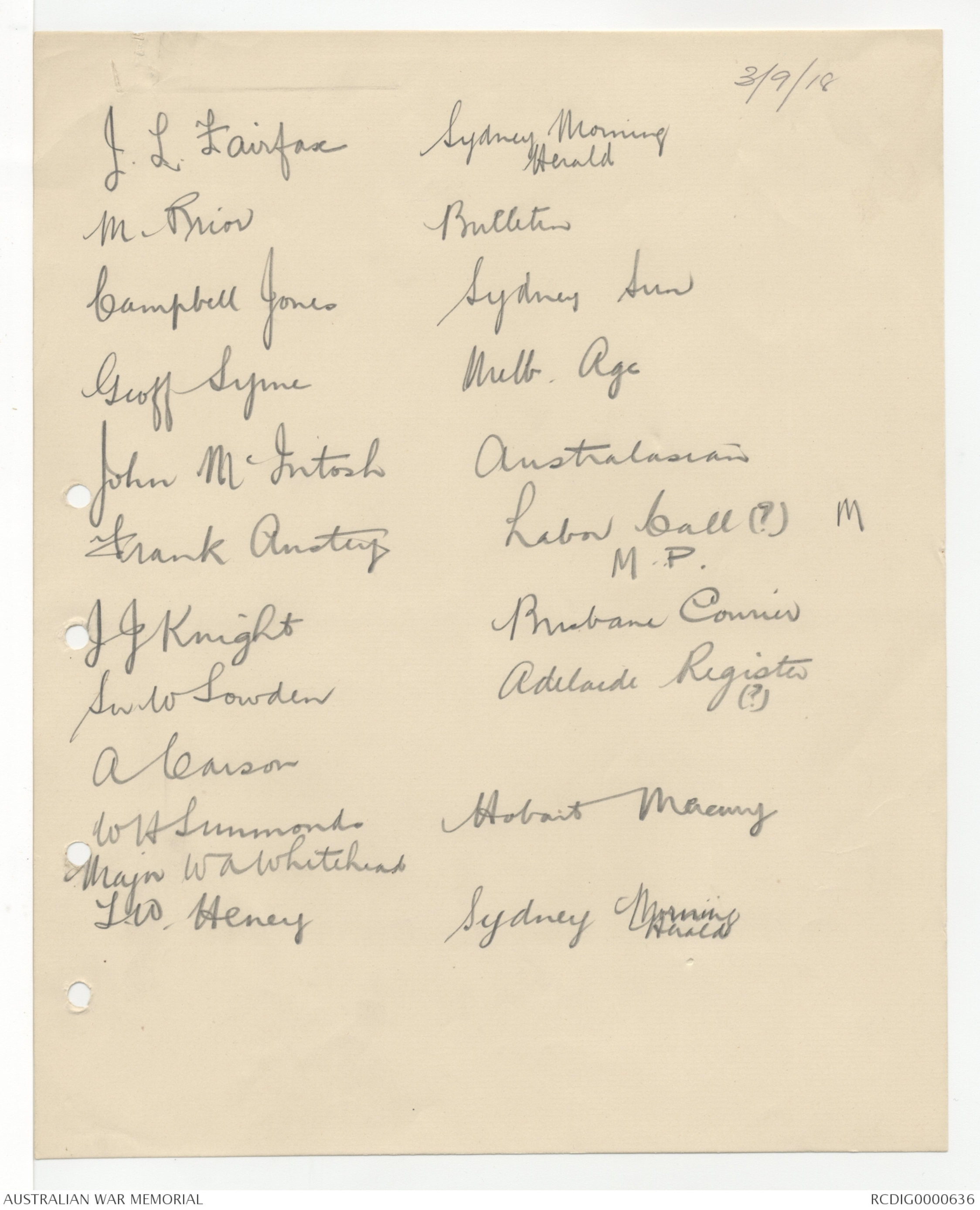
2/9/18
| TABLE OF CASUALTIES FROM 8-8-18 to 2-9-18 inclusive | ||||||||||||||||||||||||
| 1st Aust. Division. | 2nd Aust. Division. | 3rd Aust. Division. | 4th Aust. Division. | 5th Aust. Division. | 32nd |
|||||||||||||||||||
| Killed | Wounded | Killed | Wounded | Killed | Wounded | Killed | Wounded | Killed | Wounded | Killd | Wd | |||||||||||||
| Off. | O.R. | Off. | O.R. | Off. | O.R. | Off. | O.R. | Off. | O.R. | Off. | O.R. | Off. | O.R. | Off. | O.R. | Off. | O.R. | Off. | O.R. | O. | O.R. | O. | OR | |
| Phases | ||||||||||||||||||||||||
| 8th – 15thAug. |
39 |
327 |
73 |
1537 |
13 |
168 |
65 |
969 |
7 |
122 |
49 |
905 |
14 |
165 |
46 |
866 |
7 |
134 |
49 |
733 |
|
|
|
|
| 16th - 22nd Aug. |
- |
9 |
5 |
104 |
4 |
24 |
7 |
106 |
2 |
17 |
7 |
24 |
- |
53 |
13 |
220 |
1 |
40 |
4 |
184 |
|
|
|
|
| 23rd - 26th Aug. |
15 |
187 |
64 |
1499 |
- |
- |
- |
- |
5 |
83 |
30 |
592 |
- |
4 |
7 |
155 |
- |
9 |
1 |
47 |
|
|
|
|
| 27th - 31st Aug. |
- |
68 |
17 |
436 |
7 |
69 |
24 |
285 |
9 |
75 |
47 |
570 |
- |
- |
5 |
58 |
- |
56 |
21 |
223 |
4 |
99 |
27 |
379 |
| 1st - 2nd Sept. |
- |
- |
1 |
6 |
14 |
145 |
34 |
609 |
11 |
104 |
17 |
440 |
- |
- |
- |
2 |
7 |
42 |
27 |
329 |
- |
8 |
1 |
39 |
| Total by Divs |
54 |
591 |
160 |
3582 |
38 |
406 |
130 |
1969 |
34 |
401 |
150 |
2531 |
14 |
222 |
71 |
1301 |
15 |
281 |
102 |
|
4 |
74 |
28 |
418 |
| Grand Total Australian Divisions.- | ||||||||||||||||||||||||
| Killed |
155 |
Officers |
1901 |
O.R. | ||||||||||||||||||||
| Wounded |
613 |
“ |
10899 |
“ | ||||||||||||||||||||
| Missing not included - | ||||||||||||||||||||||||
|
15 |
Officers |
432 |
O.R. | |||||||||||||||||||||
| [*GOC*] |
783 |
13232 |
||||||||||||||||||||||
| [*BGGS*] |
783 |
|||||||||||||||||||||||
|
14015 |
||||||||||||||||||||||||
2nd September, 1918.
The following telegraphic message has been received
by the High Commissioner for Australia from Mr. H. S. Gullett,
Official War Correspondent with the Australian Forces in
Palestine:-
Cairo, 29th August, 1918.
The summer spent by the Australians in the
Jordan Valley is the severest since the crossing of the Canal.
The heat has been extreme, the shade temperature for months never
below 100 degrees and frequently above 120.
The enemy has always been aggressive, and dights
frequent and sharp. Our Iine has been resolutely maintained,
with heavy Turkish and German losses. The highly successful
campaign for the prevention of malaria, conducted by the
medical service, alone made the Valley habitable.
The wastage through sickness has been relatively
low. The weather is rapidly improving and men and horses
are in fine fighting trim.
General Allenby while presenting 88 decorations
to the Anzac Mounted Division has warmly congratulated the
troops on their brilliant and consistent work. He emphasised
an always increasing appreciation of the fighting qualities
of the Light Horse, and referred to the great part being
played by Australians in Fronce.
The following article has been received by the Hich Commissioner
for Australia from Mr. H. S. Gullett, Australian Official Correspondent
in Egupt.
WITH THE AUSTRALIAN LIGHT HORSE.
FROM THE CANAL TO THE JORDAN. A GENEPAL STRVEY.
PALESTINE, August.
More than twenty years ago the Australian Light Horse Brigades
clattered over the Canal bridges and commenced their famous Desert
Campaign. For a few arduous weeks they skirmished aggressively on
the defensive, while the Turks brought up their army and completed
the arrangements which they hoped would give them permanent possession
of the wide area of scattered palm groves and wells about Romani.
This was the area always aimed at by old-time invaders of Egypt.
[[?]]ure there the Turk could have mobilised soundly for the crossing
of the Canal and the capture of the teeming Nile delta and the
dest ruction of British rule in Northern Africa. But his project
disastrously failed, and the failure was due to a great extent to the
dogged resistance of the 1st and 2nd Light Horse Brigade, fighting
dismounted and greatly outnumbered first in the darkness and dawn and
later through the blinding August heat among the desert sandhills.
Simultaneously and immediately afterwards there were many bitter
subsidiary fights in which nearly all the Light Horse Regiments,
the New Zealand Mounted Rifle Brigade, the Imperial Camel battalions
of which the personnel was formed largely of Australia's one Yeomanry
Brigade and a considerable British Infantry force participated.
Then very slowly, the Turks henceforth on the defensive, the
British force moved towards Palestine, the railroad and the pipeline
which gave it food and water and which were pushed over the
desert, keeping always close to the vanguard. In December Magdhaba
was brilliantly raided and captured by the Light Horse, the New
Zealanders and the Camel Brigade, and a big bag of prisoners taken.
A fortnight later in January 1917 a second dashing raid gave us Rafa,
with another substantial haul of Turkish infantry and German and
Austrian gunners. These two fine little fights had carried the
British force clear of the hot sands of Sinai, and the change from
the desert to the flowered slopes of Southern. Palestine meant a very
happy Christmas.
In the spring the invading army moved through the wide poppied
fields of growing barley to the first swift assault on Gaza. But
meanwhile a marked change had taken place in the composition of the
Army.
THE TWO GAZAS.
Down to the first battle of Gaza and covering practically the
whole year's fighting for Palestine, the mounted troops had been
supreme. The Anzac Mounted Division commanded by Sir Harry Chauvel
the remarkably successful Queensland leader of horse, had almost
monopolised the fighting. Although in the main Australian, it
/included
-2-
included New Zealanders and Yeomanry. It was the thrusting spearhead
of the British forces and for a year it was ceaselessly active
over a very wide front and frequently engaged in heavy action.
The infantry divisions had of necessity remained close to the water
supply, and marked the boundary of the country actually conquered.
It was the sure defensive well, constantly creeping forward with
the pipe-line and the railway, and out from its protection went
the dashing adventurous regiments of the Anzac Mounted Division on
a thousand enterprises of reconnaissance and patrol and an occasional
bold raid in force. The first attack on Gaza marked the turning
point. Then and in all the fighting since the infantry has advanced
in co-operation with the horsemen.
First Gaza as it is known, went within an ace of a brilliant
and substantial success. Infantry and New Zealanders and Australians
all reached the outskirts of the town. It appeared as though the
narrow exciting sundown pictures of Magdhaba and Rafa were to be
repeated on a much larger scale. But we missed by a hairsbreadth,
and there was a wonderful pull-out end march home in the darkness.
At the Second battle of Gava, three weeks later, the Turk stood without
flinching from Gaza to Beersheba. There followed for the Light
Horse and mounted troops generally a long extremely hot summer, with
a heap of heavy work over the wide broken NO MAN'S LAND between the
two great wadys which roughly represented the opposing lines. The
dust upon the country behind our front was perhaps never equalled in
the world until we came this summer to the Jordan Valley. Upwards
of 25,000 mounted troops and all the transport for them and the
rapidly increasing infantry force, were passing ceaselessly over an
area a few miles square during many rainless months of extreme heat.
There was constant night movement. Sleep in the heat of the day was
next to impossible.
GENERAL ALLENBY TAKES OVER
The infantry divisions were strongly reinforced, and the gun
power of the force was greatly strengthened. During the summer
1917, Sir Edmund Allenby arrived as Commander in Chief. The force
recognised in him a leader whom all ranks were eager to follow.
The Enemy line was smashed from end to end in Nouember.
For sixty miles the pursuit went at the double by night and day.
The country changed almost as swiftly as the troops advanced. The
Philistine Plain became richer as we went north. Soon we were among
the pretty Jewish villages and the Orange groves of Jaffa heavy with
their golden fruit. A brief halt for supplies to come up, and then,
pioneered by the infantry, as the country was too rough for horse
except along the strongly obstructed mountain tracks, the Army struck
East for the uplands Bethelehem fell, early December found the Western
Australians entering the devious narrow streets of old Jerusalem.
In February the men of the 1st Light Horse Brigade debouched from the
mountain passes on to Jordan Valley and, galloped into the patch of irregated
gardens and hotels which make up the modern Jericho.
A month later an Australian troop of Engineers had flung the
/first
-3-
first pontoon bridge across the swift but narrow current of the Jordan
and with the Londoners, and the men of the Camel Brigade, the Anzac
Mounted Division climbed in the night up the hazardous goat tracks of
the Mountains of Moab, and after a bitter fight in extremely wet and
cold weather tore up a few miles of the Hedjaz railways south of Amman.
After this most impudent little sally ------ Amman was then many miles
from our nearest railhead and 30 to 40 miles from our "line” in the
Jordan Valley ------, there were a couple of highly successful defensive
fights by the 1st A.L.H. Brigade and an Australian Battalion of
the Camel Brigade, in which the Turkish dead ran into several hundreds,
while our losses were nominal. Then the Australian Division played
a dashing lead, and with the Anzacs and the Londoners did another fine
raid across Jordan which temporarily gave us for the second time the
old mountain-built town of Es-Salt and resulted in us getting nearly
a thousand prisoners. To the North and East of Jericho the Australian
troops have spent the balance of the summer.
ACROSS PALESTINE.
Crossing Palestine from its Western fringe beside the Mediterranian,
you traverse first the narrow lightly undulating Philistine
Plain, with its rich soils, a regular rainfall of about 30 inches a year,
and a climate mild but exhilarating in winter and cooled by sea breezes
in summer. Except for the beautiful orchard, areas of the Jewish and
German colonists it is an area treeless and unfenced. All over it you
enter each few miles, the mud and straw villages of the Arabs, a lazy
happy picturesque people who get a frugal but an easy livelihood from
the generous soil. Here occasionally to-day you find e lucky Australian
Brigade enjoying a very brief rest after a long spell in Jordan Valley
Clearing the plain you climb up the steep roads leading to
the heights of Judea. Here and not down on the fat Philistine Plain
was the real home of the Jew of the Old Testament, and the remains of
thousands of little terraces on the abrupt hillsides tell of his skill
and industry as a husbandman. On the occasional area which is level
enough for the purpose is the more regular resting place for our brigades,
and from these camps come the Light Horsemen you see every day
in the streets of Bethlehem and Jeruselem. Crossing the watershed at
the Mount of Olives, and running down towards Dead Sea and the Jordan.
a striking change comes over the country. Along the top and down the
Mediterranean slopes, the mountain although steep and rugged is relatively
soft and civilised end green. Every little valley and pocket
has its olive trees and pines.
On the Jorden side it is true wilderness, a forbidding place
of sheer, stony, dusty, sundried hillsides, precipitous and without
a blade of grass or other vegetation. As you run down the narrow
winding dangerous track through a maze of horse and motor traffic and
an almost unbroken lane of Egyptian and Arab and Indian road members,
this sense of desolation intensifies. You lose the breeze, the heat
becomes extreme, the dust grows ddeeper and deeper, and, rising stands
above the road as a choking cloud. Here and there you get glimpses of the
Valley below, a stark plain enshrouded by a hovering pall of dust extending
for many miles.
/It recalls . .
-4-
It reca ls London under a brown fog as seen from the heights of Hampstead
Heath. Winding down the middle of the plain, its course marked by a
narrow strip of green scrub, races the swift slightly muddy waters of
the Jordan. On the outer edge oy the side cloud of dust is the line
held by the Light Horse, and with them are the New Zealanders, some Yeomen
and the dashing Indian cavalrymen. For heat and dust and their
attendant evils the sacred Volley is incomparably worse than the
conditions in the dust below Gaza or in the Sinai Desert in the summer
of 1916. This is the severest spell the Light Horse have known.
3rd September, 1918.
The following telegraphic message has been
received by the High Commissioner for Auststralia from
Mr. H. S. Gullett, Official War Correspondent with the
Australian force in Palestine.
2nd September, 1918.
The Australian Flying Squadron continuing its
recent fine performances has destroyed two German
machines. After his heavy casualties during the past
month the enemy is shy of venturing over our lines, but
yesterday two twoseaters appeared at a great height.
Two Australians immediately attacked and both the Germans
crashed, one in our territory and the other just across
the Turkish lines. One of our pilots has now destroyed
four machines in seven days,
3/9/18
Press Guests.Bean
Central Signals.
Size & distribution of Corps
Ask questions
Maps.
3/9/18
I. L. Fairfax Sydney Morning
Herald
M. Ryan Bulletin
Campbell Jones Sydney Sun
Geoff Syme Melb. Age
John McIntosh Australasian
Frank Anstey Labor Call (?) M
M.P.
J J Knight Brisbane Courier
Sir W Lowden Adelaide Register (?)
A Lemson
W H Simmonds Hobart Mercury
Majn W Whitehead
Leo Heney Sydney Morning
Herald
 Sam scott
Sam scottThis transcription item is now locked to you for editing. To release the lock either Save your changes or Cancel.
This lock will be automatically released after 60 minutes of inactivity.